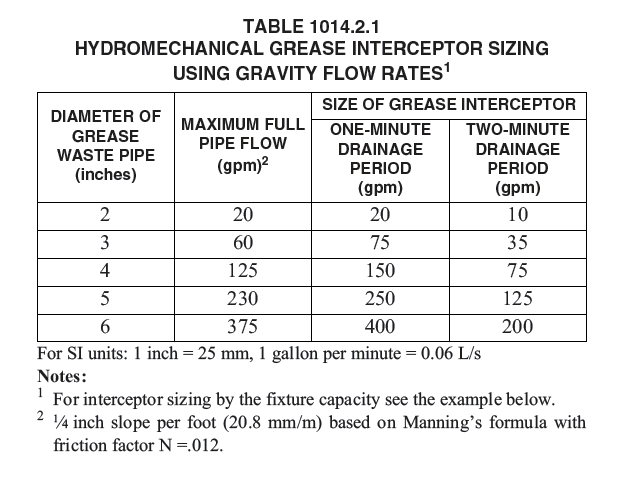October 12, 2023

From the 2021 UPC Illustrated Training Manual, Chapter 10, TRAPS AND INTERCEPTORS
1014.2.1 Capacity. The total capacity in gallons (gal) (L) of fixtures discharging into a hydromechanical grease interceptor shall not exceed two and one-half times the certified gallon per minute (gpm) (L/s) flow rate of the interceptor in accordance with Table 1014.2.1.
For this section, the term “fixture” shall mean and include each plumbing fixture, appliance, apparatus, or other equipment required to be connected to or discharged into a grease interceptor by a provision of this section.


When sizing for a hydromechanical grease interceptor (HGI) using fixture capacity, determine the compartment sizes of the fixtures and calculate the volume in cubic inches (LxWxD). Divide the volume by 231 to calculate the volume of liquid in gallons. Per Example 1014.2.1, multiply the gallons by the fill factor .75. This fill factor takes into account that the fixture is normally filled to about 75 percent of capacity, with the other 25 percent being displaced by the items placed in the fixture for washing. Therefore, the actual drainage load is 75 percent of the fixture capacity.
Once the actual drainage load is calculated, determine the flow rate per minute using a one minute or two minute drainage period. Typically, sinks will drain within a one minute period, which determines the drainage load in gallons per minute.
When would the two-minute drainage period be used? When the capacity of the fixtures (in gallons) discharging into the interceptor is 2 1/2 times the flow rate capacity of the HGI, a two-minute drainage period would be used. The code allows the capacity of the fixtures to be 2 1/2 times the flow rate of the HGI to give latitude to space constraints for an interceptor. A smaller interceptor may be used, but the consequence is a longer drainage period.
For example, a four-compartment sink is to discharge into a HGI. Each compartment size is 24x24x12. Using the method described in the first paragraph, the actual drainage load is 89.8 gallons. Using the drainage period of one minute, a HGI equal to or greater than 89.8 gpm would be required (a typical size is 100 gpm). Suppose a 100 gpm interceptor would not fit due to space limitations. The Code would allow a 50 gpm interceptor with the acceptance that the fixtures would take longer to drain. Instead of one minute, the drainage period would be extended to two minutes. Remember, the flow control device will not allow the discharge rate to exceed 50 gpm. The drainage load of 89.8 gallons is within 2ó times the flow rate of 50 gpm. If the capacity of the fixtures had exceeded 125 gallons, then a 50 gpm interceptor would not be permitted.
The 2021 Uniform Plumbing Code Illustrated Training Manual is available for purchase here.
(This is not to be considered the official position of IAPMO, nor is it an official interpretation of the Codes.)

IAPMO
IAPMO develops and publishes the Uniform Plumbing Code®,the most widely recognized code of practice used by the plumbing industry worldwide; Uniform Mechanical Code®; Uniform Swimming Pool, Spa and Hot Tub Code®; and Uniform Solar Energy, Hydronics and Geothermal Code™ — the only plumbing, mechanical, solar energy and swimming pool codes designated by ANSI as American National Standards — and the Water Efficiency Standard (WE-Stand)™. IAPMO works with government, contractors, labor force, and manufacturers to produce product standards, technical manuals, personnel certification/educational programs and additional resources in order to meet the ever-evolving demands of the industry in protecting public health and safety.
Last modified: October 19, 2023
